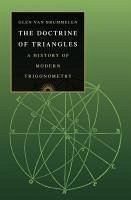
The Doctrine of Triangles
A History of Modern Trigonometry

PAYBACK Punkte
13 °P sammeln!
An interdisciplinary history of trigonometry from the mid-sixteenth century to the early twentieth The Doctrine of Triangles offers an interdisciplinary history of trigonometry that spans four centuries, starting in 1550 and concluding in the 1900s. Glen Van Brummelen tells the story of trigonometry as it evolved from an instrument for understanding the heavens to a practical tool, used in fields such as surveying and navigation. In Europe, China, and America, trigonometry aided and was itself transformed by concurrent mathematical revolutions, as well as the rise of science and technology. Fo...
An interdisciplinary history of trigonometry from the mid-sixteenth century to the early twentieth The Doctrine of Triangles offers an interdisciplinary history of trigonometry that spans four centuries, starting in 1550 and concluding in the 1900s. Glen Van Brummelen tells the story of trigonometry as it evolved from an instrument for understanding the heavens to a practical tool, used in fields such as surveying and navigation. In Europe, China, and America, trigonometry aided and was itself transformed by concurrent mathematical revolutions, as well as the rise of science and technology. Following its uses in mid-sixteenth-century Europe as the "foot of the ladder to the stars" and the mathematical helpmate of astronomy, trigonometry became a ubiquitous tool for modeling various phenomena, including animal populations and sound waves. In the late sixteenth century, trigonometry increasingly entered the physical world through the practical disciplines, and its societal reach expanded with the invention of logarithms. Calculus shifted mathematical reasoning from geometric to algebraic patterns of thought, and trigonometry’s participation in this new mathematical analysis grew, encouraging such innovations as complex numbers and non-Euclidean geometry. Meanwhile in China, trigonometry was evolving rapidly too, sometimes merging with indigenous forms of knowledge, and with Western discoveries. In the nineteenth century, trigonometry became even more integral to science and industry as a fundamental part of the science and engineering toolbox, and a staple subject in high school classrooms. A masterful combination of scholarly rigor and compelling narrative, The Doctrine of Triangles brings trigonometry’s rich historical past full circle into the modern era.













